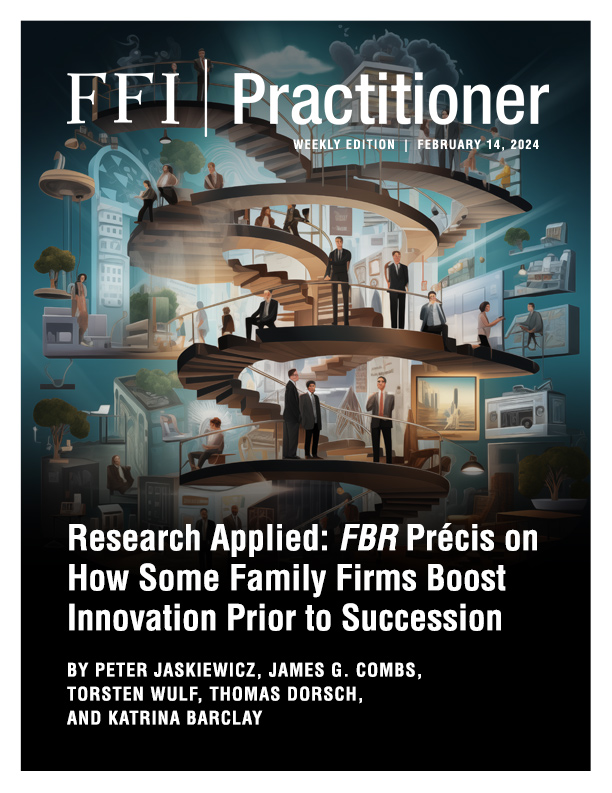
We collected data on 438 publicly listed family firms in France and followed them over several years. France offers an ideal study context: it has the largest capital market in continental Europe, and over half of its publicly listed firms have large family owners.
Reducing Conflicts Is a Fine (Board) Balance
Ownership allows families to keep a close eye on how their businesses are run, offering vital monitoring of non-family leaders to ensure they add value and are held accountable for their decisions. But when a family owns a business, they sometimes also make decisions for family or emotional reasons—such as when hiring underqualified family members or avoiding promising yet risky investments. The latter can lead to conflicts, especially with non-family shareholders, and threaten the firm’s financial performance. Our research reveals which type of family firm governance helps family owners keep a close eye on the business while limiting idiosyncratic decisions that could disadvantage non-family shareholders. These family firms reduce conflicts and enhance firm performance by having the right balance of family and non-family board members.
The Goldilocks Zone
Our research implies a “Goldilocks Zone” of family board representation that optimizes the performance of family firms, an amount of representation that is neither too much nor too little . . . but just right.
Ideal board composition is not just about the number of family members on the board or the percentage of family board seats; it’s about the balance between family members on the board in relation to the family’s ownership stake. Specifically, we found that the best firm performance occurs when the share of family members on the board is proportional to the family’s stake in the business. For example, in a firm where a family holds a 33% ownership stake, ideal family board representation would be three out of nine board seats (33%). This is the zone where firm performance is maximized. But as soon as that balance starts to shift in either direction, our analyses show that firm performance suffers.
Sidebar
by Peter Jaskiewicz, James G. Combs, Torsten Wulf, Thomas Dorsch, and Katrina Barclay
Outside the Zone: Family Overrepresentation and Family Underrepresentation
Firm performance decreases when the family is overrepresented on the board. In the same 33% ownership scenario, if two of the six non-family board members are replaced with family members—increasing the number of family directors from three to five (out of nine) —we observed a 20% decrease in industry-adjusted Return on Equity (ROE), from 4.17% to 3.33%. Why? Presumably, because the family’s increased power on the board allows them to do what they want, without enough scrutiny from non-family board members.
Underrepresentation, on the other hand, also harms firm performance. Too few family representatives on the board means the owning family does not have the power to monitor their hired managers adequately. As the main owners of a publicly listed business, it goes without saying that the family has an interest in efficient and effective decisions. In the 33% ownership scenario, imagine family owners hold only one of nine board seats. In this scenario, we observed a 49% decrease in industry-adjusted ROE, from 4.17% to 2.12%. Why? Presumably, because the family might not have the power needed to watch over and correct managerial failings, indicating more suboptimal managerial decisions and weaker board oversight. The owning family might, in this case, have what’s known as “dormant family influence,”2 opening the potential for hired non-family managers or board members to act more in their own interests and at shareholders’ expense.

Designing Better Boards: Practical Implications
Armed with knowledge about effective family board composition, family owners, non-family shareholders, and advisors can strengthen the boards of listed family businesses.
Non-Family Shareholders
- Non-family shareholders can be less skeptical about family involvement on boards. Family board participation can be encouraged if it follows the “Goldilocks” principle of the family’s board share being balanced with ownership. In this instance, our study suggests that family board members make boards more effective. Conversely, families that end up with a too-low share of family members on the board might suffer from an insufficient number of committed and responsible family members, which could help explain their worse firm performance.
- Family board involvement is not static and might need to be adapted when family ownership changes. For example, when family ownership declines (such as with the issue of new shares or an M&A), non-family shareholders can proactively start discussions about lowering the family’s share of board members to ensure the business maintains a balanced family board share-to-ownership.
Family Owners
- Family owners can be upfront with fellow family owners, non-family directors, and non-family shareholders about the negative implications of family underrepresentation on the board. As we found in our research, restricting family board involvement in relation to family ownership might contribute to a power vacuum on the board that gives too much freedom to hired managers, potentially hurting firm performance.
- It is important for family owners to communicate to the larger family about the dangers of family board overrepresentation to manage the family’s expectations about board involvement over time. As owning families grow faster than their firms, it is essential to ensure that the family’s share of board members does not automatically increase when the founder-owners transition to a more extensive sibling partnership or a sibling partnership transitions to a more extensive cousin consortium owner group. Introducing a shareholder agreement might be vital to maintain an optimal family board share in relation to family ownership over generations.
Advisors
- It is crucial for advisors to be aware that any ownership change will impact the family board’s share-to-ownership ratio. For instance, when working on a family constitution/charter and discussing the family’s vision and anticipated board involvement, it is best for advisors to caution that a family’s board share should also be viewed in relation to the family’s ownership stake and its evolution.
- When developing a shareholder agreement with family owners, discuss how changes to the family’s ownership, e.g., when a family owner sells shares to a non-family investor, could warrant a reduction in the remaining family owners’ board representation.
- Finally, it is important that advisors pay attention to the family’s growth. Before ownership might be passed on to children, advisors can proactively explain to future next-gen owners that the mere growth in the number of family owners need not translate into an increased share of family board members, and they can help the next-gen owner group establish fair processes to select the most meritorious candidates.
The Benefits of Balance
In publicly listed family firms, board composition involves more than the number and diversity of independent directors. Our research shows the importance of calculating and keeping in mind the ratio of the family’s board member share in relation to family ownership. Family and non-family shareholders need to consider the family’s ownership to harness its benefits while mitigating potential downsides. Following this approach supports firm performance and may create stronger family business governance structures. By getting the balance “just right” and setting up family owners to maintain that balance as the number of family owners changes over time, family and non-family shareholders can benefit from the best that family ownership and board involvement have to offer.
References
1 Peter Jaskiewicz, James G. Combs, Klaus Uhlenbruck, and Amlan Datta, “Revisiting the Impact of Families on Family Firm Performance,” European Management Review 21, no. 3 (2024): 678–700, https://doi.org/10.1111/emre.12606.
2 Dormant family influence refers to the “low level of family influence in the family firm [that] exists when there are few interactions between family and business systems.” From Tim Barnett and Frank W. Kellermanns, “Are We family and Are We Treated as Family? Nonfamily Employees’ Perceptions of Justice in the Family Firm,” Entrepreneurship Theory and Practice 30, no. 6 (2006): 837–854, https://doi.org/10.1111/j.1540-6520.2006.00155.x.









